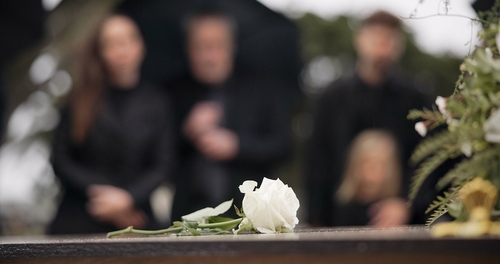At Remitly, we know how much you can discover from travelling or moving abroad. Every culture has its own unique traditions, including when it comes to funerals and mourning traditions. Death is a universal experience, but the ways we grieve and honor the deceased are shaped by our unique cultural backgrounds.
In this guide, we’ll explore some of the most interesting global funeral and mourning traditions, from celebratory send-offs to quiet memorials. You’ll gain new perspectives on grief and community, especially if you’re living abroad or a part of a multicultural family or community.
What is the purpose of funeral and mourning rituals?
Around the world, people honor the dead differently. For some, it’s a loud, colorful, celebratory ritual. For others, it’s a quiet, meditative reflection. Regardless of what a funeral looks like, there are a few key purposes that they serve in all cultures:
- Honoring the life of the deceased
The primary reason for traditional funeral and mourning rituals is to honor the life of the person who has passed away. Many traditions include photos, speeches, or reflections on the person’s life, character, and contributions to the community over the course of their life.
- Holding space for grief
During funeral rituals, families, friends, and communities come together to share in the collective loss of a person. Traditions provide a structured way to express grief during a time when support is so important. - Helping the bereaved transition
The formality or predictability of funeral traditions can help the close family and friends of the deceased respond to their loss. Often, these traditions will help the bereaved to process the loss of their loved one.
- Affirming cultural or religious beliefs
Many cultures and religions have specific beliefs about the afterlife. In some cases, there are rules and rituals that have been passed down generations that should be followed so that the deceased can transition successfully from this life to the next.
Losing a loved one is never easy. The rituals of funeral traditions help to provide comfort and a sense of shared community during a difficult time.
Funeral and mourning traditions around the world
Death itself might be universal, but how it’s approached around the world differs. This has been the case for all of time. History shows us how the ancient Egyptians filled the burial tomb with objects that would help the deceased in the next life, like money or food. The Vikings buried their dead inside of ships.
Modern rituals vary as much as the historic ones. Some traditions today involve music, dancing, and singing. Others require the bereaved to prepare the deceased for the transition to the next life. Read on to explore some of the most specific funeral traditions around the world.
Ghana: celebratory farewells and fantasy coffins
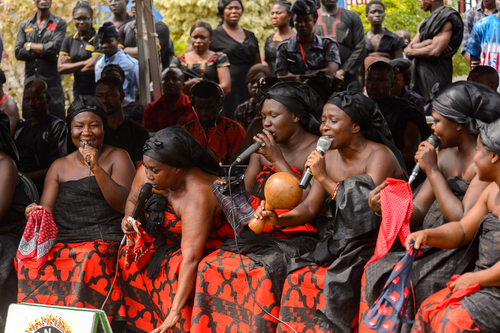
For some cultures, happiness isn’t an emotion typically associated with funerals, but in Ghana that’s what it’s all about. Funerals in Ghana are vibrant, celebratory events that draw in the whole community. There’s music, dancing, and feasts that can last for days.
Instead of being private and sorrowful, Ghanaian funerals are public and joyful. Families spend a significant amount of money to throw a celebration that honors the deceased—and everyone’s invited. Here are some hallmarks of Ghanaian funerals:
- Open invitation
A Ghanaian funeral is meant to bring together extended family, friends, and the whole community. This means that funerals are public events. Everyone gathers together to honor the deceased and support the bereaved family, ultimately strengthening community bonds.
- Symbolic dress
The common colors to wear to a Ghanaian funeral are black and red. Black symbolizes grief, while red symbolizes respect for the deceased. In some communities, white is worn to celebrate a long life. It’s common for the immediate family to wear red, while the wider community often wears white.
- Long duration
It’s not uncommon for Ghanaian funerals to require weeks or months of planning. Once the event kicks off, it can last several days. Sometimes, personalized memorabilia, like signs, t-shirts, and billboards are planned for the funeral.
- Fantasy coffins
The coffin in which the deceased is buried is often a abedu adekai or “fantasy coffin.” This is a customized piece of art that represents the deceased’s life, career, or dreams. For example, a fisherman might be buried in a fish-shaped coffin.
- Music and dancing
Live music, dancing, and traditional drumming are incorporated into the funeral tradition and often continue day and night. In some cases, “talking drums” are used to convey messages praising the deceased or offering condolences to the grieving family through specific rhythms that mimic spoken words.
- Final thanksgiving
After all of the funeral traditions take place, there is often a final thanksgiving that is held the day after. This final gathering gives thanks for the life of the deceased and for the community’s support throughout the funeral.
Mexico: Día de los Muertos (Day of the Dead)
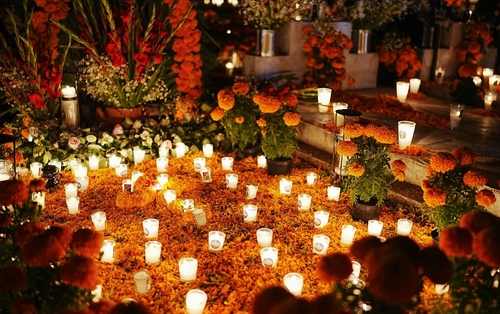
Funerals in Mexico are deeply tied to the Catholic religion. They typically begin with a velorio, or wake, which is a one- to two-day open house for praying, support, and storytelling. It’s typical for this wake to take place at the family home. This is then followed by a formal Catholic funeral mass and a procession to the burial site. It’s typical for physical burial to be preferred over cremation because of its importance to Día de los Muertos.
Día de los Muertos is a nationwide celebration that honors deceased loved ones on November 1 and 2. The celebration blends indigenous traditions with Catholicism, which was incorporated into Mexican culture during Spanish colonization. This joyful, festive celebration brings friends and family members to the graves of their loved ones, creating altars with food and marigolds. There is also traditional dress and music associated with the holiday.
- A visitation
The Mexican belief is that the souls of the deceased return to Earth on Día de los Muertos and mingle with those of the living. This is a blend of ancient Aztec tradition and Catholicism, which also celebrates All Soul’s Day on November 1.
- Symbolic dress
Celebrants dress in vibrant, colorful outfits and often paint their faces to resemble skeletons. Women wear marigolds in their hair, and men wear them in their hats. When dressed to celebrate Día de los Muertos, the women are called catrinas and the men are called catrines.
- Ofrendas or altars
In the family home, ofrendas, or altars, are set up to welcome spirits. These are decorated with candles, photographs, food, and flowers. The most common flower used throughout the Día de los Muertos celebration is the marigold. Its bright color is believed to guide the souls of the deceased.
- Festivities
Día de los Muertos is truly a celebration. There is live music and dancing throughout the night and many communities will even host parades and street fairs.
- A blend of influences
The individual funeral traditions for each deceased person happen in the weeks immediately following their death. These are typically somber, religious traditions rooted in Catholicism. Día de los Muertos provides Mexicans with the opportunity to celebrate the life of their loved ones who have passed in a more communal, festive way.
Japan: respect for ancestors and Obon festival
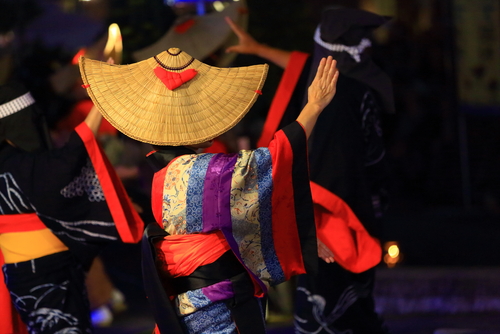
Similarly to Mexico, Japan has funeral traditions for individual people, plus a special holiday to honor the deceased communally. When a loved one passes in Japan, a solemn, meditative funeral is held, often in the Buddhist tradition. There is a two-day wake or otsuya followed by a formal funeral service or kobubetsu-shiki. After the funeral, the body of the deceased is typically cremated. You can expect Japanese funerals to be formal and for attendees to wear black.
In mid-August, Japan celebrates the Obon Festival during which deceased ancestors are commemorated and honored. During this period of time, it is believed that the spirits of the deceased return to mingle amongst the living. It’s typical to celebrate Obon by cleaning family graves and setting up altars in the home.
- Atmosphere of commemoration and tradition
The Obon Festival is deeply spiritual and cultural. Everything done during this time is to honor, respect, and remember the deceased. There is a celebratory, but respectful atmosphere during this time.
- Timing
The Obon Festival is not on a set date, but instead varies from region to region. It’s primarily celebrated between August 13 and 16.
- Bon Odori
Bon Odori is a type of communal dancing that is performed during the Obon Festival. This dance is often done around central bandstands where live music is played, often with the taiko drums.
- Lantern release
It’s typical for communities to release paper lanterns, or chochin, which are thought to serve as guides for spirits. Some communities will launch large lanterns called toro nagashi onto nearby rivers or the sea.
Jewish traditions: sitting shiva
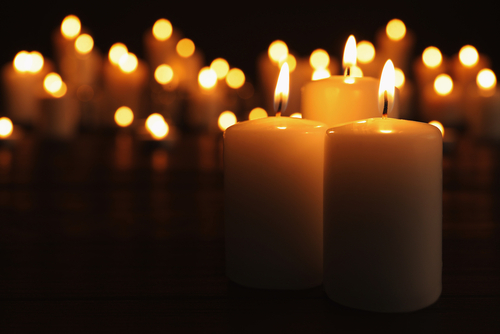
Jewish funerals are simple and solemn. Most importantly, they are held as soon as possible—often within 24 hours—after the passing of a loved one. There are usually no flowers or or wake, and the deceased is placed in a simple, wooden casket. The Jewish funeral service involves prayers and a eulogy before the body is brought to the ceremony for burial, where loved ones symbolically place earth on the casket.
Once the deceased is buried, the family and loved ones will begin a traditional seven-day mourning period called shiva, which is the Hebrew word for “seven.”
- Dignity of the deceased
According to Jewish tradition, there is no wake or viewing of the body. This is to honor and respect the dignity of the deceased. Similarly, mirrors are covered or avoided during the mourning period. This is to shift the focus from external appearance to internal grief and memory.
- Conservative dress
Attendees of a Jewish funeral, or shiva typically wear conservative clothing, like long skirts or pants. The shoulders should always be covered. Men will wear a head covering, or yarmulke.
- Seven days of mourning
Shiva is the entire week after the funeral of a loved one. The immediate family of the deceased will remain in their home. During this period, friends and community members will stop in to bring food and comfort. Together, attendees may recite the mourner’s Kaddish prayer.
- Shiva candle
At the start of shiva, a special candle is lit. This candle will remain burning for the entire seven days of mourning, not to be extinguished until the end of the shiva.
Madagascar: Famadihana, “the turning of the bones”
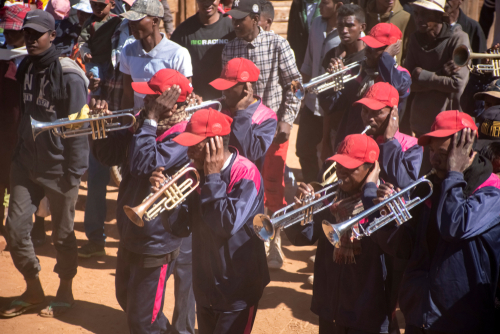
In Madagascar, the burial process is ongoing through the tradition of famadihana or “the turning of the bones.” In this practice, families periodically exhume their deceased loved ones in order to wrap them in fresh burial cloths and dance with them in a joyful, celebratory ritual. The famadihana usually takes place every five to seven years, bringing families and communities together to remember their loved ones.
- Celebration and dance
The Malagasy people approach the famadihana with a joyful attitude. When the bodies of their deceased are cleaned and wrapped in fresh cloths, often made of silk, they then celebrate with music, dancing, and plenty of food.
- A transition from body to spirit
In Madagascar, it’s believed that after death, your spirit can only join the world of the ancestors after complete decomposition of the physical body. So, the famadihana becomes a way for the living family of the deceased to care for them during this period of transition to the spirit world.
- Seeking blessings
The dead are viewed as powerful intermediaries who can affect the fortunes and blessings of the living. Famadihana is not just a celebration of kinship and remembrance, but also an opportunity to ask ancestors to intervene beneficially on your behalf.
Celebrating life
Wherever you are in the world, we all need community. While funeral and mourning traditions differ greatly across the globe, they all share a common purpose of honoring life, processing grief, and bringing people together.
Learning about how different cultures, communities, and religions approach the grieving process can foster greater empathy and understanding. This is especially true for immigrants and those in multicultural communities.
FAQ
Why are funeral traditions so different around the world?
The differences in funeral traditions are rooted in diverse religious beliefs, cultural values, historical events, and philosophical views on life, death, and the afterlife. Each tradition is a unique expression of a community’s—and an individual’s—identity.
What is the most common funeral practice globally?
While practices vary widely, both burial and cremation are common worldwide. The choice often depends on religious doctrine and cultural norms. For example, burial is traditional in Islam and Judaism. Cremation is prevalent in Hinduism and Buddhism.
How can I show respect for a funeral tradition I’m not familiar with?
Even asking this question is a great start! If you have the time, research the type of funeral you’re attending beforehand to get an idea for what to expect at the event. Alternatively, you can ask a friend or family member about expectations beforehand.
Once there, be observant and follow the lead of other attendees. Dress conservatively unless you’re told otherwise. It’s always appropriate to quietly express your condolences to the family.
